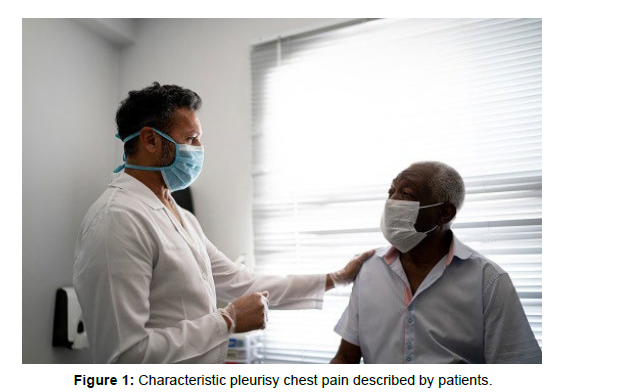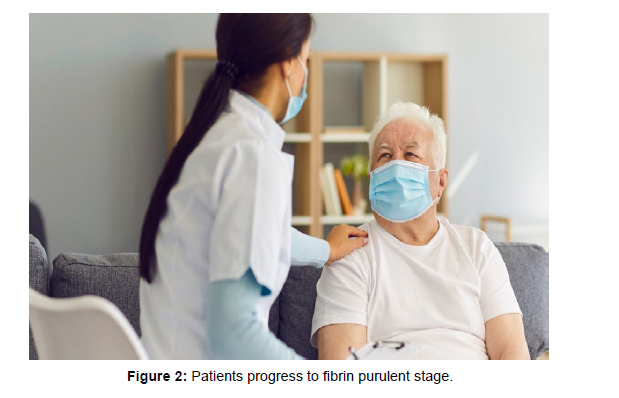Pulmonary Findings Predict Mortality in Pneumonia Patients
Received: 29-Aug-2023 / Manuscript No. JRM-23-115754 / Editor assigned: 01-Sep-2023 / PreQC No. JRM-23-115754 / Reviewed: 15-Sep-2023 / QC No. JRM-23-115754 / Revised: 21-Sep-2023 / Manuscript No. JRM-23-115754 / Published Date: 28-Sep-2023 DOI: 10.4172/jrm.1000180 QI No. / JRM-23-115754
Abstract
In healthy adults, the pleura space contains a small volume of low protein fluid that forms a lubricating film about thick between the visceral and parietal pleura surfaces. A pressure gradient facilitates movement into, but not out of the pleura space, as intra-pleura pressure is lower than interstitial pressure, and pleura membranes are leaky, offering little resistance to liquid or protein movement. The majority of pleura fluid exits the space by bulk flow, rather than diffusion or active transport, through the parietal lymphatic.
Keywords: Fluid filtration; Malignant effusions; Vascular permeability; Neutrophils; Coagulation cascade; Proteases
Keywords
Fluid filtration; Malignant effusions; Vascular permeability; Neutrophils; Coagulation cascade; Proteases
Introduction
Pleura fluid accumulates when the rate of formation exceeds the rate of absorption. The flow of pleura lymphatic can efficiently increase in response to an increase in pleura fluid filtration, acting as a negative feedback mechanism. The lymphatic flow is the typical amount of pleura fluid formed per day. Due to the large lymphatic capacity, unless the lymphatic drainage is severely impaired, another factor must be present for pleura fluid to accumulate. The most common cause of increased pleura fluid formation is increased interstitial oedema. This can occur as a result of several processes and is the predominant mechanism for the formation of Para pneumonic effusions along with pleura effusions related to congestive heart failure, pulmonary embolism and acute respiratory distress syndrome [1]. Decreased pleura pressures can also contribute to pleura fluid accumulation, as in advanced empyema when the visceral pleura become coated with a collagenous peel and trap the lung. Increased capillary permeability, particularly when the pleura become inflamed, also contributes to pleura effusion formation. Lymphatic obstruction is a common mechanism contributing to malignant effusions. The evolution of para pneumonic effusion is divided into three progressive stages, exudative stage, fibrin purulent stage and organizing stage with pleura peel formation. In the early exudative stage there is a rapid outpouring of fluid and inflammatory cells into the pleura space due to increased capillary microvascular permeability [2]. This directly results from pro-inflammatory cytokines, such as interleukin and tumour necrosis factor.
Methodology
The inflammatory process of the pulmonary parenchyma extends to the visceral pleura causing changes to the mesothelium cells lining the pleura, allowing increased fluid movement [3]. This causes a local pleurisy reaction, and the characteristic pleurisy chest pain described by patients as shown in (Figure 1). Researchers studying rabbits infected with intrapulmonary pseudomonas found a dose dependent relationship between bacterial levels and extent of alveolar epithelial injury, which further facilitated entry of alveolar protein and bacteria into the pleura space. This occurred within hours of inoculation [4]. The pleura fluid in this early exudative stage is usually clear free-flowing exudative fluid with predominance of neutrophils, and characterized by negative bacterial cultures, glucose level greater than and above lactic acid dehydrogenase less than three times the upper limit of normal for serum and low white cell count [5]. Pleura fluid that develops during this stage is usually considered a simple para pneumonic effusion and treatment with antibiotics is often adequate, without the need for tube drainage. Patients can progress to further stage, the fibrin purulent stage within hours if effective treatment is not provided as shown in (Figure 2). This next stage is characterized by deposition of fibrin clots and fibrin membranes in the pleura space, leading to loculations and isolated collections of fluid [6].
Discussion
Invasion of bacteria from the pulmonary parenchyma occurs across the damaged endothelium. This invasion accelerates the immune response and directly contributes to fluid loculation by promoting further migration of neutrophils and activation of the coagulation cascade. This leads to increased pro coagulant and decreased fibrinolysis activity, which encourages fibrin deposition and promotes formation of septation within the fluid [7 ]. The inflammatory reaction is further fuelled by neutrophil phagocytosis and bacterial death, which results in release of more bacteria cell wall derived fragments and proteases. The anatomy of the pleura fluid is based on three features, size, whether it is free flowing and whether the parietal pleura are thickened. The bacteriology of the effusion is based on whether pleura cultures or smears are positive [8]. The chemistry of the pleura fluid is based on measured with a blood gas machine. Pleura fluid glucose can be used as an alternative to pH with a cut-off level. Based on the classification, the effusion is categorized. Risk of poor outcome is based on the category of the effusion, as are recommendations to drain the effusion. Similarly, the British Thoracic Society has published a diagnostic algorithm for management of these patients [9]. The infectious organisms of community-acquired pneumonia vary according to patient population, host immunity and geographic region, with the most common pathogens including pneumonia, haemophilia influenza and Staphylococcus aurous [10 ]. However, despite the relationship with pneumonia, studies suggest the bacteriology of pleura infections differ from that of pneumonia and have been altered significantly with the institution of antibiotic treatment. In a study of patients with pleura infections, approximately para pneumonic infections were due to species, with the most common being intermedias, followed by pneumonia. Staphylococcus species were also common and accounted for about the para pneumonic infections. In this series, another, para pneumonic effusions were due to anaerobic bacteria. Most other series report similar rates of anaerobes [11]. However when amplification and research laboratories are used to identify organisms, anaerobes may be present in up to cases. The difference in the bacteriology between pneumonia and pleura infections may be related to the acidic and hypoxic environment of the infected pleura space and bacterial virulence factors favouring certain pathogens [12]. Furthermore, the difference in bacterial species between pleura infections and pneumonia, along with lack of chest imaging evidence of pneumonia in some patients, have led some experts to question the conventional belief that empyema and pneumonia are inherently related [13]. Haematogenous spread of bacteria from systemic infection or an abdominal process with rapid growth of bacterial in the pleura space, as observed in animal models, offers a plausible explanation. Aside from inflammation in the lungs and pleura space from direct invasion of bacteria and bacteriologic virulence features contributing to para pneumonic effusion, patient factors and comorbidities also contribute to the pathophysiology of Para pneumonic effusion development [14 ]. A recent study, analysed patients had pleura effusions, of which had empyema or complicated para pneumonic effusion. In a multivariable analysis, no single baseline patient characteristic distinguished patients without pleura effusion from those with uncomplicated para pneumonic effusion. However, five independent baseline characteristics could predict the development of empyema or complicated para pneumonic effusion in patients with pneumonia, alcoholism, pleura pain, tachycardia and leucocytosis. These investigators and others have found a reduced prevalence of clinical manifestations in older patients, suggesting possible age related change in the immune response. In this cohort, researchers also found patients with a history of tobacco abuse had increased risk of developing a complicated Para pneumonic effusion or empyema, whereas, chronic obstructive pulmonary disease and heart failure decreased risk.
Conclusion
Diabetes, chronic renal disease and liver disease were not associated with risk of pleura infection in the cohort. Similar results have been found in other prospective observational studies of patients diagnosed. Pneumonia is a leading cause of death and pleura infections complicating pneumonia has been established to have considerable morbidity and mortality, with mortality approximately for patients with empyema. This may be related to something inherent about the para pneumonic effusion and/or a more robust inflammatory response. Underlying comorbidities or patient factors may not only contribute to the development of a Para pneumonic effusion, but might be the cause of increased mortality.
Acknowledgement
None
Conflict of Interest
None
References
- Cunningham AA, Daszak P, Wood JLN (2017) One Health, emerging infectious diseases and wildlife: two decades of progress? Phil Trans UK 372:1-8.
- Sue LJ (2004) Zoonotic poxvirus infections in humans. Curr Opin Infect Dis MN 17:81-90.
- Pisarski K (2019) The global burden of disease of zoonotic parasitic diseases: top 5 contenders for priority consideration. Trop Med Infect Dis EU 4:1-44.
- Kahn LH (2006) Confronting zoonoses, linking human and veterinary medicine. Emerg Infect Dis US 12:556-561.
- Bidaisee S, Macpherson CNL (2014) Zoonoses and one health: a review of the literature. J Parasitol 2014:1-8.
- Cooper GS, Parks CG (2004) Occupational and environmental exposures as risk factors for systemic lupus erythematosus. Curr Rheumatol Rep EU 6:367-374.
- Parks CG, Santos ASE, Barbhaiya M, Costenbader KH (2017) Understanding the role of environmental factors in the development of systemic lupus erythematosus. Best Pract Res Clin Rheumatol EU 31:306-320.
- Barbhaiya M, Costenbader KH (2016) Environmental exposures and the development of systemic lupus erythematosus. Curr Opin Rheumatol US 28:497-505.
- Cohen SP, Mao J (2014) Neuropathic pain: mechanisms and their clinical implications. BMJ UK 348:1-6.
- Mello RD, Dickenson AH (2008) Spinal cord mechanisms of pain. BJA US 101:8-16.
- Bliddal H, Rosetzsky A, Schlichting P, Weidner MS, Andersen LA, et al (2000) A randomized, placebo-controlled, cross-over study of ginger extracts and ibuprofen in osteoarthritis. Osteoarthr Cartil EU 8:9-12.
- Maroon JC, Bost JW, Borden MK, Lorenz KM, Ross NA, et al. (2006) Natural anti-inflammatory agents for pain relief in athletes. Neurosurg Focus US 21:1-13.
- Birnesser H, Oberbaum M, Klein P, Weiser M (2004) The Homeopathic Preparation Traumeel® S Compared With NSAIDs For Symptomatic Treatment Of Epicondylitis. J Musculoskelet Res EU 8:119-128.
- Gergianaki I, Bortoluzzi A, Bertsias G (2018) Update on the epidemiology, risk factors, and disease outcomes of systemic lupus erythematosus. Best Pract Res Clin Rheumatol EU 32:188-205.]
IndexedAt , Google Scholar, Crossref
Indexed at, Google Scholar, Crossref
Indexed at, Google Scholar, Crossref
Indexed at, Google Scholar, Crossref
Indexed at, Google Scholar, Crossref
Indexed at, Google Scholar, Crossref
Indexed at, Google Scholar, Crossref
Indexed at, Google Scholar, Crossref
Indexed at, Google Scholar, Crossref
Indexed at, Google Scholar, Crossref
Indexed at, Google Scholar, Crossref
Indexed at, Google Scholar, Crossref
Indexed at, Google Scholar, Crossref
Citation: Saunders M (2023) Pulmonary Findings Predict Mortality in PneumoniaPatients. J Respir Med 5: 180. DOI: 10.4172/jrm.1000180
Copyright: © 2023 Saunders M. This is an open-access article distributed underthe terms of the Creative Commons Attribution License, which permits unrestricteduse, distribution, and reproduction in any medium, provided the original author andsource are credited.
Share This Article
Recommended Journals
Open Access Journals
Article Tools
Article Usage
- Total views: 594
- [From(publication date): 0-2023 - Apr 04, 2025]
- Breakdown by view type
- HTML page views: 403
- PDF downloads: 191


